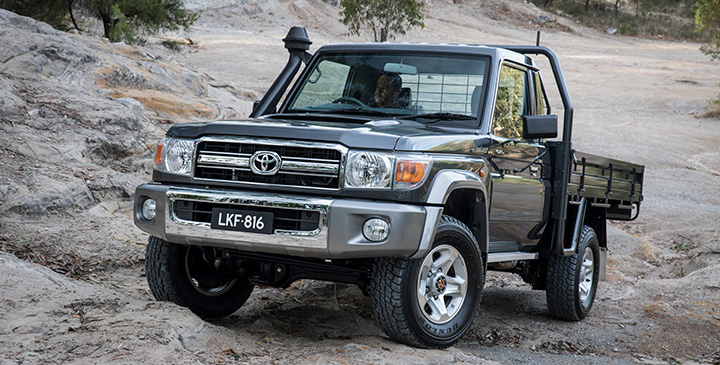LandCruiser 70 Series is tougher than ever before
Available in late 2016, the legendary LC70 comes with a range of upgrades that make it even more indestructible for your fleet. Toyota Australia’s engineers put the single-cab model to the test, pushing it for over 100,000km in the harshest conditions around the country.
The 4.5 litre V8 turbo-diesel engine packs a punch. But don’t let its power fool you, all LC70 variants will now have a perfectly geared manual transmission to improve fuel economy compared to current model*. On single-cabs, the frame is built even stronger, boasting upgraded side rails to reduce vibration and improve handling and stability, also suspension has been upgraded too.
Then there’s the long list of new safety features like the addition of driver’s knee and curtain shield airbags bringing the total up to an impressive five on the single-cab version. And for a solid stance, the whole range comes with Vehicle Stability and Traction Control to enhance your grip on the road.
To help prevent accidents, the entire range also comes with Brake Assist which can detect when a driver brakes heavily in an emergency, then additional braking is applied to help them stop sooner. And for added peace of mind, Electronic Brake-force Distribution spreads the braking force, which is particularly important when you’re carrying heavy loads. And did someone say Cruise Control? Yes, that’s included too – a saviour for those long-haul trips.
With all this and more, it’s easy to see why LC70 is a natural choice for fleet.
* Fuel consumption and emissions will vary depending on driving conditions/style, vehicle conditions and options/accessories. Source of fuel consumption data: ADR 81/02 combined cycle.
LandCruiser to the rescue
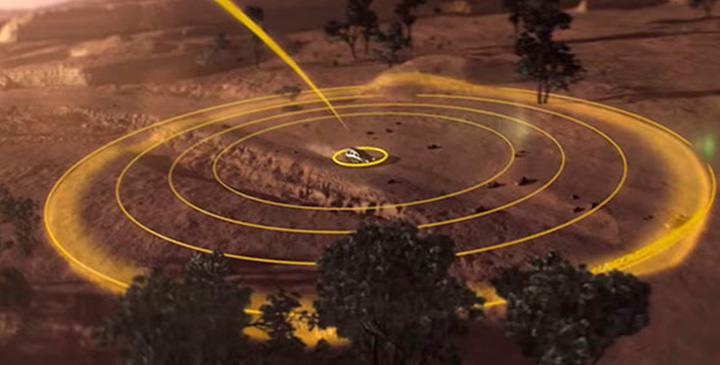
LandCruiser Emergency Network (LEN) is a pop-up emergency network powered by everyday LandCruiser drivers. It is an ongoing project aiming to bring emergency mobile signal to the 65% of Australia’s landmass that currently receives none.
By leveraging Australia’s most widely used 4x4, it’s possible to bring emergency communications to some of the most remote parts of the continent.
The Problem
Over 5 million square kilometres of Australia still receives no mobile signal. That’s an area of mostly harsh Outback the size of Western Europe. In times of emergency such as fire, flood or stranding, this lack of reception can be incredibly dangerous.
At the same time, Australia is the world’s biggest market for LandCruisers. There are over 500,000 of the legendary vehicles operating throughout the country. Thanks to their toughness and durability, they are often the only vehicles you’ll see in rural and remote areas.
So while you might be far from cell-phone tower in the Outback, you’re never far from a LandCruiser.
The Network
The LandCruiser Emergency Network is based around a simple, inexpensive, signal-providing device that is installed into volunteers’ LandCruisers. These units connect together to create a roving mobile network anywhere it’s needed.
During emergencies where the LandCruiser Emergency network is live, communities are able to communicate amongst themselves and with the outside world.
The Technology
Toyota and Saatchi & Saatchi worked with experts in Rural, Remote and Humanitarian Telecommunications from Flinders University, South Australia, to create a signal providing device specifically for LandCruisers. These devices use a mix of technologies including wifi and digital UHF, with cellular to be activated pending licensing agreements.
Each unit creates a mobile hotspot with a range of up to 25km. During emergencies anyone within range can use the network to log a call or send a geo-tagged message straight from their ordinary mobile phone.
This data is then passed from vehicle to vehicle on a store-and-forward basis. As soon as one of these vehicles gets in range of a network base-station, first responders can be alerted. And in times of large-scale emergencies such as fire or flood, this technology can create a network within the emergency zone so people can organise their disaster response.
This Delay and Disruption Tolerant Networking is the same kind of technology being investigated by NASA for interplanetary communications.
HiAce and Tarago – now even better equipped for your fleet
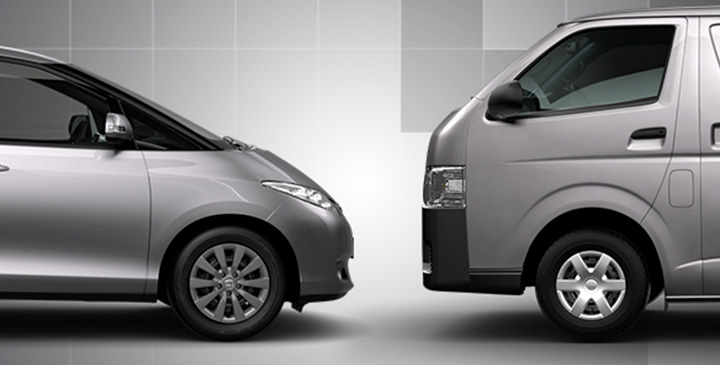
Introducing a new HiAce line-up
It’s no secret that HiAce is built to work hard. And with new diesel variants to choose from, you have even more reason to consider HiAce for your fleet.
The new diesel line-up includes the option to remove the rear side window on the Long Wheelbase Van automatic model. Plus there are two additional 12 seater Super Long Wheelbase Commuter Bus variants.
Improvements to Tarago
As a Fleet Customer, you know that Tarago is the ultimate support vehicle. Now it comes with additional features to make it much more than a handy people mover.
When it comes to your fleet drivers, safety is a must. Thanks to Tarago’s new technology, you’ll have the peace of mind they have the best protection, with an Emergency brake signal that alerts other drivers in the event of sudden braking.
Of course, a little extra comfort and style can go a long way towards improving employee and customer relations. The new Tarago range is no exception with a modern, spacious interior that includes a revamped instrument panel, sleek new meter design and more sophisticated touches. It also includes a 4.2'' Multi-Information Display to enhance visibility, plus a Reversing Camera to assist driver control. Needless to say, it’s a more enjoyable driving experience all-round.
And there’s more good news. With a price rollback from August 2 across the entire range, the Recommended Retail Price (RRP) now starts from $45,490, which is $1,500 less than the previous RRP. Factor in your fleet discount and you could be looking at some serious savings to your bottom line.
Petrol Vehicles in 2030: A Green Horizon
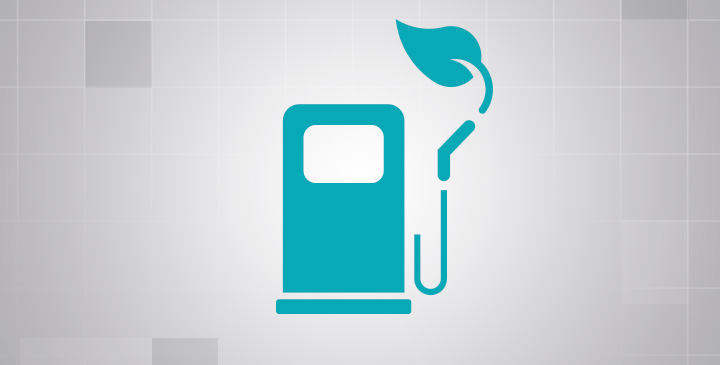
Weaning Australian motorists off traditional petrol and diesel vehicles is happening at a glacial pace; however, new research based on the views of a wide range of experts has predicted that dramatic changes are on the horizon.
The study, led by the Queensland University of Technology, found that petrol-powered vehicles will continue to dominate the market in 2030. However, according to the academics, industry leaders and government representatives interviewed for the survey, market shares for both petrol and diesel vehicles will halve over the next 15 years.
At the same time, hybrids and battery electric vehicles will grab significantly higher slices of the market. In fact, hybrids are forecast to leap into second place, accounting for about one-quarter of all new vehicles sold here. Perhaps the biggest surprise is the prediction that battery-powered vehicles will move into third place, with diesel tumbling to fourth.
This 2030 scenario is a far cry from the situation today. More than 98 per cent of new vehicles sold in Australia are still powered by petrol or diesel – a figure that has hardly moved from a decade ago. Within that broad picture, though, there have been big changes. Petrol now accounts for about 67% of sales, down from almost 85% a decade ago while the proportion of diesel-powered sales has doubled over the same period to more than 30% due to the surge in popularity of SUVs and utes that increasingly have more car-like interiors.
The diesel boom flies in the face of growing concern about carbon emissions and their impact on the environment. Diesel engines generally emit more noxious gases and particulate matter than petrol vehicles. In response, the international community is acting decisively. The government of France – a country where 80% of motorists drive diesel-powered cars – wants to phase out the use of diesel fuel for private motorists, admitting that the country’s preference for the diesel engine was ‘‘a mistake’’. Norway’s government wants to go even further: it is aiming to ban all petrol and diesel cars – including hybrids – from 2025. Australia is also moving through a federal government review expected to lead to outcomes including tougher emissions and fuel-efficiency standards.
These developments encourage other innovations such as fuel-cell vehicles like Toyota’s Mirai, which is now available in selected countries and in Australia as part of a three year trial. Fuel-cell technology is a promising alternate for the future because it offers the same cruising range, refuelling time and convenience as today’s petrol-powered cars while its only tailpipe emission is water.
Apart from benefits to the environment, the QUT study provided further good news for consumers. The interviewed experts estimated that prices for alternatives such as hybrids and battery vehicles are expected to fall between 11 and 25 per cent by 2030 while prices for conventionally fuelled cars are expected to be stable.
Whatever the eventual result by 2030, it is clear that a combination of increasing action on the environment, technological advances and hip-pocket priorities will be fundamental to shaping the future new-vehicle market.
Annual sales on track for an all-time Australian record
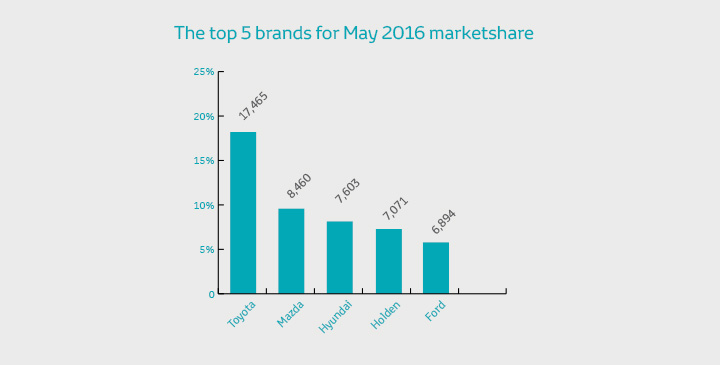
While it wasn’t exactly Christmas in July for dealers, the slight sales dip last month hasn’t been enough to dent the buoyant Australian market.
New vehicles sold in the Australian market last month came in at 91,331units, down 1.1 per cent on last year’s figures. But with annual sales already at 689,471 units, up 2.8 per cent on last year, 2016 remains poised to break annual sales records.
Business fleets have continued to fuel the impressive figures. While private sales fell 13 per cent compared to July 2015; rental sales upped their stakes by 33.5 per cent to 5,799 units and government sales dropped 7 per cent to 3,212 units.
For Toyota Australia, the news was good across the board. The company announced its best July in four years, selling twice as many new vehicles as any of its rivals.
In the small car market, Toyota Corolla knocked Hyundai i30 off its perch to claim top position as Australia’s best-selling model with a tally of 3,427 vehicles sold.
Close on Corolla’s heels was HiLux, which had a stellar month, increasing market share to 21 per cent and outclassing Ford Ranger to take second spot.
Overall, Toyota was Australia’s number 1 automotive brand, with an increase of 3.7% in sales compared to July 2015 and four vehicles in the Top 10, including Camry and RAV4.
Other winners included Ford, which continued a strong showing by selling 20 per cent more units than they did in July 2015 and Kia, at 3,555 units up by 30.5 per cent.
Toyota Australia’s executive director sales and marketing Tony Cramb said the results proved the company was right to buck the trend of focusing on June end-of-financial-year sales at the expense of July.
‘‘A consistent approach to managing our business and focusing on our customers has enabled Toyota to achieve a healthy July-on-July sales increase on top of a robust market-leading result in June,’’ he said.
‘‘As a result, Toyota has stood out by selling almost 40,000 vehicles over the past two months, while also achieving an appreciable gain in market share for July.’’
Toyota gives O’Brien Glass a clear advantage
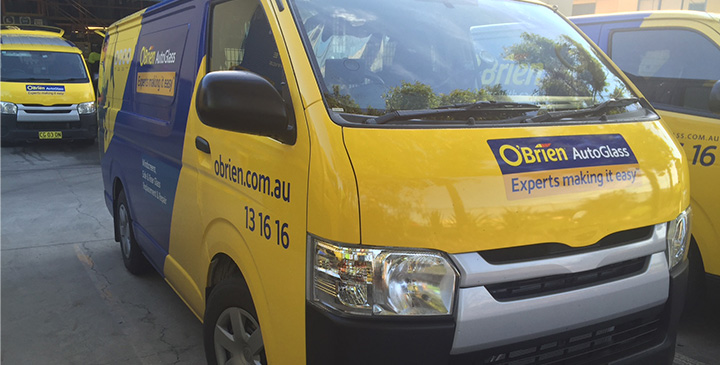
As one of Australia’s best-known Business, Home and Automotive glass repair and replacement businesses, O’Brien Glass have forged a reputation for excellent, dependable service anywhere they’re needed. Which is why O’Brien Glass relies on a sizeable fleet of Toyotas to help get the job done.
‘‘The Toyota vehicle range fits in our HR policy, the vehicles are reliable, drive well in Australian conditions and most importantly, work with our overall staff safety policy,’’ said Craig Kortum, Procurement & Property Manager..
The company has two major divisions. AutoGlass carries out chip repairs and replaces windscreens and side/rear glass, with branches in over 60 locations around Australia. While O’Brien Home and Business has 19 branches, delivering a mobile service to its customers.
Each division requires a diverse range of vehicles to meet the various needs of employees and customers; from a mobile fleet made up of HiAce vans and HiLux, to supporting vehicles such as RAV4, Kluger and Camry. All up, the company runs 381 Toyotas.
Understandably, when working with a product as fragile as glass – in all terrains and weather – safety is paramount.
‘‘First, we look for the highest safety standards,’’ Craig said. ‘‘HiAce have the highest safety level achievable in its class. Then we look at warranty terms and dependability, and HiAce ticks all the boxes. It’s also durable, fit for purpose and stylish.’’
The company has been delighted with the HiAce’s solid economic performance too.
‘‘In general, we don’t have issues with them being off the road other than normal servicing,’’ Craig said. ‘‘We made the decision to drive diesel engine vehicles and the HiAce diesel is quiet and economical to drive.’’
Craig also rates HiAce’s practical design features, including driver comfort and the cabin fitout.
‘‘The internal dimensions let us fit out the van with equipment, racks and shelving that mean our technicians can be completely self-sufficient on the road. Little things, like having a tailgate that swings upwards also lets our technicians work in the back without getting wet if it’s raining.
‘‘Over the years, we’ve seen new features in HiAce vans that make them even easier to drive in all day.’’
The versatile HiLux has also proved a popular choice with different roles in the business. The Double Cab SR model lets Branch Managers drive customers and staff in comfort, and work when they need to.
Training technicians like the lockable ute feature in the Workmate’s Dual Cab model. While the HiLux 4x4 Dual cabs are specifically fitted out to meet stringent mine safety requirements.
‘‘The new features show us that Toyota is actually listening to recommendations from customers like us and incorporating them into their new design specs where they can,’’ Craig said. ‘‘Our experience with Toyota Australia has been a very positive one.’’

